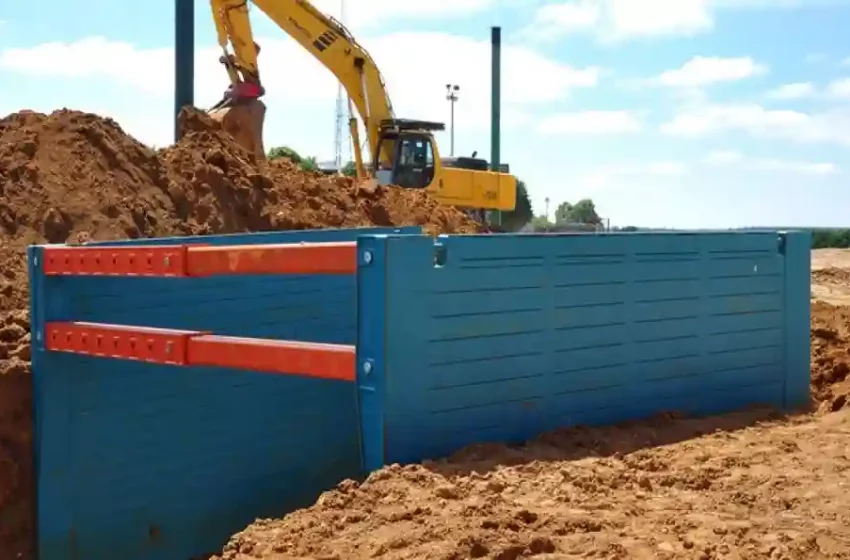
Trench Box: Ensuring Safety in Excavation Projects
Excavation projects involve digging trenches for various purposes, such as laying utility lines or constructing foundations. However, working in trenches poses significant risks, including cave-ins and soil collapse. To ensure the safety of workers and maintain project efficiency, the use of a trench box is essential.
In this article, we will explore the importance of trench boxes, their types, working principles, installation guidelines, and safety considerations.
What is a Trench Box?
A trench box, also known as a trench shield or trench shoring system, is a protective structure used in excavation projects to prevent soil collapse and provide a safe working environment for workers. It is typically made of robust materials like aluminum or steel and is installed inside the trench to support the surrounding soil.
The Importance of Trench Box in Excavation Projects
The primary purpose of a trench box is to protect workers from cave-ins and soil collapse while working in trenches.
By providing structural support to the trench walls, a trench box minimizes the risk of accidents and injuries. Additionally, it helps to maintain the integrity of the surrounding infrastructure and prevents damage to utility lines or adjacent structures.
Types of Trench Boxes
4.1 Aluminum Trench Boxes
Aluminum trench boxes are lightweight and easy to handle, making them suitable for smaller excavation projects. They offer excellent corrosion resistance and are ideal for use in environments with high moisture content. Aluminum trench boxes are often used in utility installations, repairs, and maintenance work.
4.2 Steel Trench Boxes
Steel trench boxes are known for their strength and durability. They provide robust protection in challenging excavation conditions, such as deep trenches or projects involving heavy equipment. Steel trench boxes are commonly used in large-scale construction projects, including building foundations and underground infrastructure development.
4.3 Hydraulic Trench Boxes
Hydraulic trench boxes offer added flexibility and convenience during installation and removal. These boxes can be adjusted to fit different trench widths, allowing for efficient use across various project requirements. Hydraulic trench boxes are popular in projects where trenches need to be excavated at different depths or where shoring needs to be adjusted during construction.
How Does a Trench Box Work?
A Trench Box works by creating a protective barrier between the trench walls and the workers inside. It supports the soil, preventing it from collapsing into the trench. The trench box is installed in sections as the trench is excavated, providing continuous protection throughout the project. Proper installation involves securely placing the trench box against the trench walls and ensuring it remains stable during excavation.
Advantages of Using Trench Boxes
- Enhanced worker safety: Trench boxes significantly reduce the risk of accidents and injuries by preventing soil collapse and cave-ins.
- Time and cost savings: By providing a stable working environment, trench boxes enable efficient excavation and minimize delays due to accidents or soil instability.
- Compliance with regulations: Many countries have strict regulations regarding trench safety. The use of trench boxes helps construction companies meet these regulatory requirements.
- Protection of infrastructure: Trench boxes prevent damage to underground utility lines, adjacent structures, and existing infrastructure, reducing the potential for costly repairs.
Factors to Consider When Choosing a Trench Box
Before selecting a trench box for an excavation project, several factors should be considered:
7.1 Soil Conditions
Different soil types require specific trench box designs and configurations. Understanding the soil’s stability, water content, and composition helps determine the appropriate trench box to ensure maximum safety.
7.2 Project Specifications
The depth and width of the trench, along with any specific project requirements, must be taken into account when choosing a trench box. The box’s dimensions should align with the excavation parameters to provide optimal protection and support.
7.3 Safety Features
Inspect the trench box for safety features such as built-in ladders, escape hatches, and secure locking mechanisms. These features enhance worker safety and facilitate swift evacuation in case of emergencies.
7.4 Cost Considerations
Evaluate the rental or purchase cost of the trench box and compare it with the project budget. Consider the long-term benefits and potential cost savings associated with using a high-quality trench box.
Proper Installation and Use of Trench Boxes
Proper installation and usage of trench boxes are crucial for their effectiveness. Follow these guidelines to ensure the optimal functioning of a trench box:
- Conduct a thorough site assessment and analyze soil conditions before commencing excavation.
- Choose a trench box suitable for the specific project requirements and soil conditions.
- Ensure the trench box is securely installed, providing full contact with the trench walls and proper alignment.
- Regularly inspect the trench box during excavation to identify any signs of movement, settling, or damage.
- Train workers on the correct procedures for entering and exiting the trench box, as well as emergency evacuation protocols.
- Never exceed the manufacturer’s specified depth or width limits for the trench box.
- Remove the trench box promptly after the excavation work is completed, following proper dismantling procedures.
Safety Guidelines for Working in Trenches
While trench boxes provide significant safety benefits, it is important to adhere to additional safety guidelines when working in trenches:
- Always wear appropriate personal protective equipment (PPE), including hard hats, high-visibility clothing, and safety footwear.
- Establish a clearly marked perimeter around the excavation site to prevent unauthorized entry.
- Regularly inspect the trench for signs of instability, such as cracks, bulges, or water accumulation.
- Ensure proper ventilation and air quality inside the trench, especially in confined spaces.
- Monitor weather conditions and suspend excavation activities during heavy rains, storms, or other adverse conditions.
- Have a rescue plan in place and keep necessary emergency equipment readily accessible.
Trench Box Maintenance and Inspection
To ensure the ongoing safety and effectiveness of trench boxes, regular maintenance and inspection are essential. Follow these guidelines:
- Clean the trench box after each use to remove any debris or soil that may affect its performance.
- Inspect the trench box for any signs of damage, such as dents, cracks, or bent components. Repair or replace damaged parts promptly.
- Check the locking mechanisms, ladders, and escape hatches for proper functioning.
- Lubricate moving parts, such as hinges or adjustable components, to ensure smooth operation.
- Store the trench box in a dry and secure location to prevent corrosion or damage.
- Schedule routine inspections by a qualified professional to assess the trench box’s condition and compliance with safety standards.
Common Challenges and Solutions
Working with trench boxes can present certain challenges. Here are some common issues and their solutions:
11.1 Limited Workspace
In cramped or narrow spaces, selecting a trench box that offers a compact design or adjustable configurations can help overcome workspace limitations.
11.2 Soil Stability Issues
Unstable or loose soil may require additional support measures, such as soil stabilization techniques or complementary shoring systems, in conjunction with the trench box.
11.3 Compatibility with Other Equipment
Ensure that the trench box is compatible with other excavation equipment or machinery that will be used in the project. This compatibility ensures seamless workflow and optimal safety.
11.4 Compliance with Regulations
Stay informed about the specific regulations and standards governing trench safety in your region. Adhere to these requirements when selecting and using trench boxes to avoid penalties and ensure worker safety.
Best Practices for Trench Box Usage
Follow these best practices to maximize the safety and efficiency of trench box usage:
- Conduct thorough training sessions for workers on proper installation, usage, and safety protocols related to trench boxes.
- Maintain open communication channels between workers and supervisors to address any concerns or issues related to trench box usage.
- Regularly review and update safety policies and procedures to reflect the latest industry standards and best practices.
- Stay informed about advancements in trench box technology and consider upgrading to newer models that offer enhanced safety features and ease of use.
The Future of Trench Box Technology
As technology continues to advance, trench box designs and materials are evolving to provide even greater safety and efficiency. Some emerging trends in trench box technology include:
- Lightweight yet robust materials that offer improved strength-to-weight ratios.
- Modular trench box systems that allow for easy customization and flexibility.
- Integrated sensor systems for real-time monitoring of soil conditions and trench box stability.
- Automated installation and removal mechanisms to streamline processes and reduce manual labor.
Conclusion
Trench boxes play a vital role in ensuring the safety of workers in excavation projects. By providing support and protection against soil collapse, trench boxes minimize the risk of accidents and injuries. It is essential to choose the right trench box for each project, considering soil conditions, project specifications, safety features, and cost.
Proper installation, usage, maintenance, and adherence to safety guidelines are crucial for the effective functioning of trench boxes. As technology advances, the future holds exciting possibilities for further improving trench box technology and enhancing worker safety.



